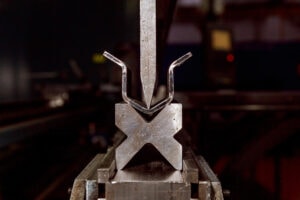Intro
Working with sheet metal takes a lot of practice before you become proficient at it. To speed up the learning process and boost your success, we came up with 7 tips to help out. In this beginner’s guide, we’ll be talking about sheet metal: how it works, how to work with it, and tips to get better results.
How Sheet Metal Gets Bent
Sheet metal is a thin, malleable piece of metal. Since it’s so thin, you can bend it and it will keep its shape. To bend sheet metal, you simply need to squeeze it between parts that are stronger than the sheet metal.
If you have a strong metal die with a strong metal punch, you can put a piece of flat sheet metal between the two, and you’re left with a bent piece of sheet metal.
In a machine shop, a piece of sheet metal can get bent in a variety of different ways. We might use a special brake tool, a customized jig, an assortment of dies and punches, an air bending machine, u-bender, or even rolling. In all of these cases, a stronger and more rigid piece of metal will bend the sheet into specific shapes.
With a thin enough gauge, you can even bend sheet metal by hand, but this practice is not repeatable or precise enough to use in a machine shop.
Common Applications for Bent Sheet Metal

There are a ton of reasons why you might make a part with bent sheet metal. Very common examples are shrouds or housings for electronics, bracketry, or safety covers.
If you have a rolling machine in your production facility, OSHA says that you need to have some form of cover to prevent people from sticking their fingers into the roller. We can grab a thin sheet of metal, bend it in a few minutes, and send it over to you. Just like that, you have an OSHA-compliant (and more importantly, a safe) protection for your machine.
You’ll see sheet metal used a lot in custom applications, since it’s so easy to work with and the design work is pretty minimal.
7 Beginner Tips for Bending Sheet Metal
If you’re looking to bend sheet metal, consider these 7 tips. These are the same tips that our expert machinists use every day.
Remember the Springback
One of the toughest parts of bending sheet metal is learning about springback. It’s the idea that the sheet will change its angle after you remove it from the press brake. What does that mean? Imagine you put your sheet metal in the brake, bend it, measure an angle of exactly 90°, then remove it from the brake. At that instant, the angle won’t be 90° anymore. Depending on the gauge and type of your material, it could be 100° or even more dramatic.
In most applications, you’ll overbend the piece a certain amount to accommodate for springback. There is no exact science here, and it truly is something that comes with enough experience.
For now, just remember to measure your angle after bending the piece.
Always Use a Press Brake
A press brake is a special form of equipment that’s specifically used to bend sheet metal. It’s typically the best option, since it gives a lot of support and results in cleaner bends.
Our advice is to use a press brake whenever possible. Even a rudimentary press brake is faster, cleaner, and more repeatable than alternatives on the market.
Make Sure the Metal is Malleable Enough
Some material is more malleable than others, and some options are simply too stiff to work with. For reference, malleability is the measure of how easy it is to bend a piece into a different shape, and how much springback you might expect.
Metals like copper and mild steel are insanely easy to bend. On the opposite end, 6061 aluminum and titanium are a pain in the neck. Starting with the right material is always going to impact how easy it is for you to bend the shape.
Use a Bend Allowance
A bend allowance is a quick way to ensure the bent metal works and meets the design. It factors in the bend angle, outside setback, bend radius, and material thickness to find the bend allowance — basically, it’s a centerline along the bend.
After finding your bend allowance, you’ll know how to dimension flange faces and holes to ensure everything lines up after the bend is complete.
Use Heat for Thick Bends
If you have to work with thick sheet metal, you might need to use a little heat. Heating up the metal before bending it will help the material move and keep its shape through the bend. Trying to cold bend a thick piece of aluminum can weaken the bend, lead to cracks, or even break the piece.
Mask the Surface to Protect it
Bending a piece of metal can cause cracks and scratches along the bend line. This can really hurt the final appearance of the part, so we suggest using masking tape to protect the metal before bending. This doesn’t always work, but it definitely prevents minor scuffs and scratches.
Plus, it’s really easy and affordable to apply, so it’s always worth trying out.
Always Plan Your Bends
You should never start bending a piece of sheet metal until you come up with a plan. This is even more important if the bent part has holes and flanges that need to be correctly dimensioned.
You should think about what type of bend you’re doing, how you’ll achieve it, and any other considerations before you start the fabrication process. Also, remember to measure twice and cut (or bend) once.
Conclusion
With these 7 tips, you should see more success in your bent projects. For expert help during your next manufacturing project, reach out to our team at Rapid Axis. We have a team of master machinists who can tackle a wide range of fabrication tasks. We also offer post-processing and a number of non-traditional machining services. Get a free quote today.

